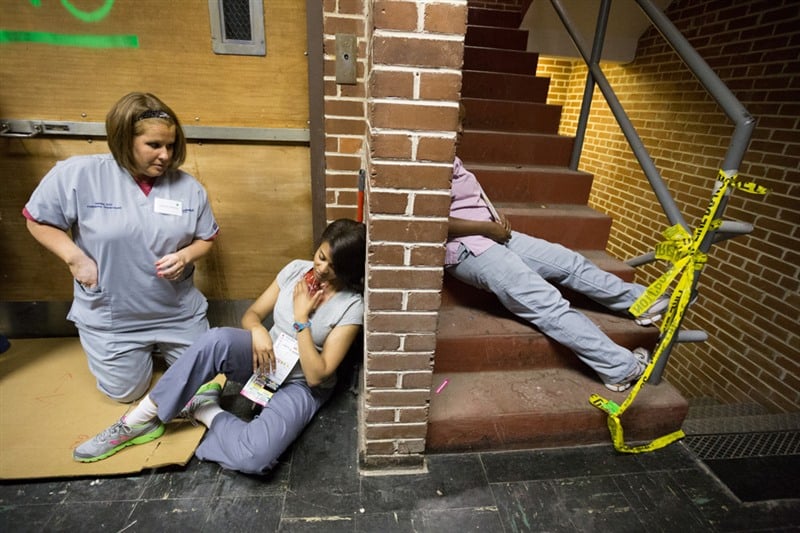Our Medical Training Ground

06.14.2014
The Daily News
Saving lives mission critical at Medical Education & Research Institute
You can’t perfectly simulate a real-life disaster. Dr. Joe Holley knows this better than most.
He was at The Pentagon after 9/11, where all too soon the reality hit that he was part of a recovery effort and not a rescue mission.
He was in New Orleans after Hurricane Katrina, where he was part of a medical team that did 1,764 triages on the first day.
“Many people were dehydrated, and we had several cardiac arrests that day,” said Holley, who is a member of Tennessee Task Force One and EMS Medical Director for Memphis and Shelby County. “Time was important – (I thought), ‘I know there are lives I can save.’”
One day, there may be many lives at stake in Memphis – after a tornado, a flood, an earthquake or a mass shooting. And while any training that precedes such an event can’t fully prepare police, fire and medical personnel for what they will encounter, it can help.
“It’s like rehearsing a play,” said Lt. Jim Strickland of the Memphis Fire Department.
So it was that on a recent spring day dozens of people came to the Medical Education & Research Institute in Memphis for the “active shooter” course. They heard lectures, they went into a lab to learn how to use the new iTClamp from iTraumaCare that controls severe bleeding, and they trained in a three-story building in which law enforcement and medical personnel would try to rescue as many shooting victims as fast as possible.
Strickland was outside, overseeing the triage area where the most severely injured patients – played by some students in the course – were lying on a red tarp. Less seriously hurt patients were assigned to a yellow tarp, and those with minor injuries a green tarp.
“You’ll have to babysit them or they’ll walk off,” Strickland said of the people with sprains and strains. “Law enforcement, that’s the first people they’ll want to talk to in the event this suspect got out.”
In this scenario, however, the suspect does not get out. In this exercise, an actual police officer portrays the bad guy, firing blanks from an automatic rifle, and leaving behind dead and wounded on the first two floors before taking his own life after police chase him into a tower-like room on the top floor.
A team of five cops – most private security guards by actual occupation – are the first to enter the building in pursuit. Mannequins are lying in various places on the first floor, as are real people imitating victims; several people are screaming, including a woman cradling a tiny mannequin in the corner of the stairwell between the first and second floors.
Her re-enactment is Oscar-worthy.
“My baby!” the woman yells, rocking back and forth as desperation sweeps across her face. “My baby!”
Another man, not into his role quite as much, points and says to the officers: “He’s upstairs.”
The cops bound up the steps, and soon there is a single gunshot, then a few moments of silence, and then an instruction that cues the start of the rest of the exercise.
“He’s dead,” an officer says into his radio. “Call it out. One shooter down.”
More than 20 years ago, Dr. Kevin T. Foley, who is medical director/chairman at MERI, was chief of neurosurgery at the U.S. Army’s Walter Reed Medical Center in Washington.
Spinal injuries were not uncommon among soldiers. But Foley noticed a gap in education and real-world training.
“It turned out a lot of doctors that had completed formal training had not learned some of the newer techniques for repairing the spine,” Foley said.
So Foley set about changing that, starting a course that offered “hands-on training in the anatomy lab” so established surgeons could learn the latest techniques.
When Foley came to Memphis to work for Semmes-Murphey Neurologic & Spine Institute, he was at the forefront of soliciting support from the Methodist and Baptist health care systems, and MERI was founded in 1992; the doors at Cleveland and Monroe opened in 1994.
Today, MERI is governed by a 12-member board of directors, which includes leaders from its charitable organizations Baptist Memorial Health Care, Methodist Le Bonheur Healthcare and Semmes-Murphey, and has 35 full-time employees.
With an annual budget of about $8 million, according to institution development manager Diana Kelly, nonprofit MERI trains more than 13,000 physicians and medical personnel annually and from all across the globe. MERI not only supports hands-on training in all medical specialties, but staff and anatomic donors also support training on the Medtronic and Wright Medical mobile labs, which contain six operating rooms, and travel to other training sites and conferences in the United States and Canada.
Each year, Kelly said, MERI receives 600 to 700 anatomical donations.
“Any subspecialty can utilize a portion of a donated body – fresh-frozen, if you will, not embalmed – and the tissue will be exactly the same as when the person was alive, except there will be no blood flow,” said Dr. David Cunningham, a neurosurgeon at Semmes-Murphey and medical director of the Memphis Regional Gamma Knife Center.
In 2008, MERI added a Simulation Center of Excellence, funded by a $1.5 million grant from the Assisi Foundation of Memphis. Since then, the organization has received program support grants that included a $250,000 matching grant from the Plough Foundation to support first-responder training in Shelby County. Other grants are in process or pending.
Joni Shulman, associate director at the American Association of Neurological Surgeons in Rolling Meadows, Ill., says they solicit corporate support from their partners and have sent surgeons to courses at MERI about 35 times in the last 10 years, with doctors coming in for training in several areas, including vascular, endovascular, skull base anatomy and spine.
“It’s incredible in terms of the procedures they can do,” said Cheryl Stegbauer, assistant dean of nursing at the University of Tennessee Health Science Center.
Just as valuable is the opportunity to see what Stegbauer calls the “unexpected finding.” Medical histories are provided on each donor, so while one disease process or injury may have caused death, the students also “get to see the consequences in multiple organs,” Stegbauer said.
Holley says a gunshot is a good example of a wound that can lead to unexpected findings.
“Part of the focus today, on the ballistics injuries,” Holley said during the active shooter course, “is to give the folks taking care of patients sort of a view inside because all we see is two little holes and blood coming out, right?
“Well, a variety of things can happen. A lot of times, the injury is not what you would think. I’ve done a wound right here,” he said, touching a spot near his shoulder, “that resulted in a liver injury because the bullet went in, hit a bone and went south. These things are very unpredictable, and the damage they can do is very widespread.”
Shulman also praised MERI for the way it conducts training, especially given that sometimes nonmedical personnel are observing in the anatomy lab.
“The spine course is set up in stations like a multiple surgical suite,” she said. “The specimens are gowned and draped, and only the part of the spine they’re working on is exposed. It’s very well-done.”
The MERI also can provide a proving ground for new medical devices. Such was the case for the iTClamp, which underwent regulatory testing at MERI and today is standard equipment on Memphis fire trucks.
The clamp is small and looks like a hair clip, or perhaps a potato chip bag clip.
“It mimics what a surgeon does with a suture needle, closing the wound shut,” said Steve Dralle, a vice president with Innovative Trauma Care in San Antonio. “But it does it in a matter of seconds, and that controls the bleeding.”
Dralle says it’s designed for use by infantry soldiers, and the company believes it will eventually become an “over-the-counter” device. For now, however, in Tennessee, it’s approved for use by paramedics but not EMTs, Dralle said.
“The way we approach the lab here, I’ve got police officers doing stuff in the lab they’ll never do in the field,” Holley said. “But that’s OK. They get to see how it works and get a chance to do it where it’s safe. They have a better understanding of what the medic has to deal with when he gets there.”
Dralle says that early on, the makers of a new device have to provide situations that will allow medical professionals to develop confidence the device will deliver. MERI is the perfect setting for accomplishing just that.
“It’s not just getting them to believe what our marketing department says,” Dralle said. “It’s really more of a conviction exercise than training, and that’s critical for a new product.”
The new products are just as critical for MERI.
“What’s helped sustain MERI is that Memphis is a world center for medical devices,” Foley said. “It turns out a facility like MERI is not only good for training; it’s also useful for engineers and design specialists. It allows them to take their devices from paper to the human anatomy, and that leads to refinements. And that’s a substantial advantage.”
Considering everything that goes on at MERI – from teaching the basics of suturing to a nurse practitioner, to using robotics in neurosurgery, to re-enacting the aftermath of a natural disaster or mass shooting – there seems little question that the training there has saved lives.
“Many, many,” said Cunningham, one of the founding board members.
Mistakes during training are part of the package, like the active shooter course’s “sift-and-sort” process of determining who is dead, who is alive, and who is injured and how seriously.
“This was designed to be screwed up,” Holley tells the students in the post-course wrap-up. “This is the place to screw it up. But we did have some interesting learning times.”
For instance, the first sift-and-sort team went into the building and put black tags on the dead bodies and marked the injured with orange tags. A couple of problems developed: The team ran out of supplies, and when it went back outside for more, it got stuck outside without law enforcement protectors, who were still inside. Also, the medics didn’t take any injured people with them when they left the building.
“Don’t ever make a dead-end trip,” Holley says.
All in all, Holley is very pleased because 26 people were taken out of the building to the triage area in less than 20 minutes.
“Nineteen minutes to clear the building,” Holley tells students, which includes all manner of medical and law enforcement personnel. “Compared to Columbine and 259 minutes. That’s making a difference. That’s a lot of lives saved.”
It is also, as Lt. Strickland from the Memphis Fire Department put it, just a rehearsal. But given that words such as Columbine and Sandy Hook convey a singular, ominous meaning, no amount of rehearsing or training can be too much. Truth is, the active shooter course at MERI is now considered just as essential as the teaching of new neurosurgical techniques.
“It’s just a matter of time until it happens here,” Strickland said. “It’s not if; it’s when.”
By Don Wade
